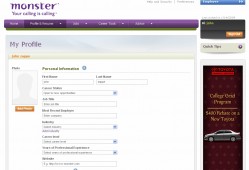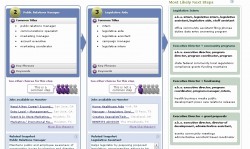I don’t fit neatly into anyone’s standard job taxonomy. So it was no surprise that in the “new” Monster (profile; site) none of the industry choices really fit “My Profile.” What was a surprise, not to mention a disappointment in this new, “user-centric” incarnation, is how much work it is for a jobseeker to play.
 I took a test run through the new Monster and read the few blog posts and comments that have sprouted since the site’s launch on Saturday. Joel Cheesman’s “Hit-and-miss” assessment of the site was unexpected, given his distaste of the big job boards. As useful a perspective as he offered on New Monster, it’s John Sumser’s observation that strikes me as the most prescient: “The most interesting thing about the launch is the loud yawn heard around the web.”
I took a test run through the new Monster and read the few blog posts and comments that have sprouted since the site’s launch on Saturday. Joel Cheesman’s “Hit-and-miss” assessment of the site was unexpected, given his distaste of the big job boards. As useful a perspective as he offered on New Monster, it’s John Sumser’s observation that strikes me as the most prescient: “The most interesting thing about the launch is the loud yawn heard around the web.”
Considering the company supposedly spent $130 million reworking and relaunching its sites in the U.S. and abroad, it so far hasn’t gotten that much bang for its bucks. At least not in the recruitment blogosphere. It may be that the multi-million dollar TV campaign, built around humor (a page from the CareerBuilder playbook), will drive in the jobseekers. But it’s too early to tell, though a Monster spokesman is checking on numbers for me.
The few actual reviews have been positive, if lukewarm. Eric Shannon, founder and head of LatPro (profile; site), was fairly positive about the relaunch. He didn’t go into any detail except to mention the widgets that let users customize the presentation of the Monster homepage and to laud the videos of the engineers and designers responsible for the new site. There’s also a blog post over at U.S. News about the site that mostly quotes Cheesman.
At the end of the day, of course, it’s going to be how the jobseekers – active and especially passive – react to the changes. Which brings me back to the amount of effort a jobseeker has to invest in using the site’s features. While the company’s claim that it’s 70 percent easier to upload a resume seems true enough, it’s 100 percent harder to fill out the rest of profile elements. You don’t have to do that to search and apply to jobs. But if you want to make sure your resume is as findable as possible and that you can make full use of the site, completing the profile is required. Or at least that’s what the company would have the jobseeker believer. After all, it says right on the site that, “Your Profile is the key to getting the most from Monster.”
 Alas, filling out the profile questionnaire is a lengthy process, not at all helped by the lack of a resume parser. I took a look at the profile questions and saw enough duplication with the resume that I did what any experienced job hunter would and uploaded the resume first.
Alas, filling out the profile questionnaire is a lengthy process, not at all helped by the lack of a resume parser. I took a look at the profile questions and saw enough duplication with the resume that I did what any experienced job hunter would and uploaded the resume first.
A brief word about the resume. Uploading is every bit as easy as the hype says. However, the confirmation email warns that you can’t edit it, but must instead make the changes to the original and upload it again. Why then does the resume open in an editing window, which, in fact, did allow me to make changes?
That aside, the Word document came up pretty clean, even if the system doesn’t handle tables too well, deleting some key things like employment dates and all the contact information.
Once it was uploaded, I expected it would be parsed into the profile. Not so. I still was required to reenter things like address, phone numbers, employment history, education and so on. That was true whether the resume was in Word or text.
I expected I might have to clean up some things, especially after going through the registration process that marked some fields as mandatory, but in fact compelled me to fill in them all. That may be a mere nit, though put enough together and it causes confusion or, at the worst, annoyance. Here’s another, more serious nit: Each time I uploaded a resume or edited one, I got an email saying, “your Word resume is now stored and accessible in our database.”
Uh, oh. I thought I set it private. Checked it and sure enough I did. So what does it mean it’s “accessible?” Further down in the email it says something about making my resume searchable, “if you haven’t already.” No help there.
If you dig around the resume dashboard you’ll see the status of each of the five resumes a person can have. And all were private, but there is a lingering sense of uncertainty. And it didn’t help matters that every confirmation mentioned a Word document, even when it was text.
 It was the lack of resume parsing that was truly annoying. Each time you upload a resume the profile window opens with a fill-in-the-fields form that asks for much of the same information that’s on the resume. That might have been necessary a few years ago. Today, even mail order parsers can divine a phone number and an address, not to mention the most recent employer and figure out that a B.A. is most likely an academic degree.
It was the lack of resume parsing that was truly annoying. Each time you upload a resume the profile window opens with a fill-in-the-fields form that asks for much of the same information that’s on the resume. That might have been necessary a few years ago. Today, even mail order parsers can divine a phone number and an address, not to mention the most recent employer and figure out that a B.A. is most likely an academic degree.
There are some nice personalization touches. Users can upload a picture of themselves and edit it on the site. There’s an “About Me” section that lets you make a personal statement and a “Career Highlights” section to bullet point those business achievements.
What’s not clear is how all these additional bits and bytes are handled in the backend by recruiters accustomed to searching for resumes with keywords and phrases.
To its credit, Monster has also done a lot to improve the job searching process. Even without filling in the profile fields I got a list of recommended jobs, some of which actually fit. Many, like loan processor, came out of left field. Though the more I cooperated with the system, filling in more and more fields, the better the job selection got. Rolling over the titles brought up the first few dozen words, sparring me from clicking back and forth.
The search results are also vastly improved from the chronological presentation of the “old” Monster. My search for, well, never mind what I went looking for, but it brought up relevant jobs and offered me multiple ways of limiting the results.
I’m more ambivalent than Cheesman is about the career tools. Seems to me there is value there for individuals at the early stage of their career, for those considering a career change or for those who never really thought about the idea there might be a career path. So in the “Showcase Paths” of the career mapping section a telemarketer could see how to become an underwriter in five steps. Or a forklift operator can see where they might go next on the career ladder.
 The process can be confusing and, frankly, some of the maps I created by following the steps Monster outlined produced such unlikely results as the telemarketer becoming an insurance underwriter. My search for a career path starting with “journalist” produced no result, which, now that I think about it, might be a comment about future prospects in that field.
The process can be confusing and, frankly, some of the maps I created by following the steps Monster outlined produced such unlikely results as the telemarketer becoming an insurance underwriter. My search for a career path starting with “journalist” produced no result, which, now that I think about it, might be a comment about future prospects in that field.
One omission here is the lack of any social or networking tools. How cool would it be for that telemarketer to connect with someone who actually became an underwriter? Could they have done it? Sure, if the registration process invited individuals to participate in a Web 2.0 community, the way LinkedIn and even Jobster have.
If the goal here was to engage the passive jobseeker, Monster will have to do a better job letting them know what’s there and then helping them use the tools once they try them.
On the recruiter side, new job categories have been added and resume search supposedly has been enhanced, but only some changes have been implemented and few are completely visible.
Monster’s press release says, “The product allows employers to target desired seekers by advertising where relevant seekers are searching and navigating the site. Also benefiting employers, Monster has begun rolling out a new employer site experience designed to improve the overall recruitment process. New enhanced resume search, job and candidate management, job posting wizard and online resource center tools are designed to help employers increase productivity and maximize their recruitment return on investment.”
So what’s the verdict? Overall an A for effort; an incomplete for execution; a C for innovation, with a final grade to come later, once jobseekers and candidate seekers have had a chance to explore and use the new Monster.